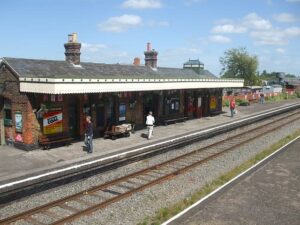•
(Caution: Contains spoilers for Episode: S08E01: Things That Go Bump in the Night)
Diesen Beitrag gibt es auch auf Deutsch.
•

Joyce and Tom Barnaby are guests of Elizabeth Key in Fletcher’s Cross. They go out of the cottage into the garden. Elizabeth Key carries a tray with three cups and saucers, sugar bowl and creamer. Joyce carries the teapot in her hand. The two women walk side by side in front, Tom Barnaby with his hands in his trousers behind.
The Barnabys admire the garden and the location and Elizabeth Key enlightens them that back then in Victorian times, there was a railway just behind a row of trees near the house. Joyce is startled and apparently imagines express trains. But back then they were only steam locomotives, of course. However, the line was later closed.
Now, the railway is to be partially restored and Fletcher’s Cross Station reopened. We learn later at the railway inauguration festival that it is mainly thanks to James Griss! But he is not quite respected in Fletcher’s Cross because he is a bit of a show-off.
Barnabys and Elizabeth Key sit down at a small table and set it and talk about Elizabeth’s parents and the upcoming meeting of the Spirit of Friendship Group. Just before the scene change, you hear the rattle and toot of a steam locomotive, but you don’t see it.
A steam locomotive is also seen in Great Worthy in another episode (14×03: Echos of the dead), but without any further information about the railway system there.
Old, new railway stations
The episode takes up a rather topical theme – both at the time of filming and the first broadcast and today. In the 19th century, the construction of railways was booming, even in rural areas, but in the 1950s, 1960s and 1970s, many of these railways were closed down because they were no longer lucrative enough.
Especially since the turn of the millennium, there have been repeated initiatives to reopen these disused stations. Though the plans always fail to materialise because demand remains too low or costs too much to open. And that is also the difficulty in Fletcher’s Cross. That’s why James Griss is talking to potential investors.
Some former railway stations become museums – like Quainton Road Railway Station, now Buckingham Railway Centre. Fletcher’s Cross station was filmed there. The name of the village is Old English for Queen’s Estate. It presumably refers to the estates of Edith, who was the wife of King Edward the Confessor.
A good 800 years later, in 1860, the Aylesbury and Buckingham Railway Company was founded and the line opened 8 years later. Initially it only connected the Wycombe Railway (Maidenhead-Abingdon) in Aylesbury to the south and the Verney Junction of the Buckinghamshire Railway (Bletchley-Banbury-Oxford) to the north. In 1899 a junction was added to the north just beyond Quainton station, linking the line with the Great Central Main Line (Sheffield-London).
Unlike the connection from Fletcher’s Cross to Causton, the Aylesbury and Buckingham Railway had no connection to Wallingford, 30 miles (about 50 km) away, which is known to be the filming location for Causton.
Quainton Road Railway Station

Quainton Road Railway Station was one of six stops on the Aylesbury and Buckingham Railway. Although it opened in 1868, it was not worthwhile in this underpopulated area and yet it was probably the most important stop on the line. It had a special status because the Brill Tramway started here – or ended here, depending on which way you were travelling.
The Brill Tramway’s main purpose was not to transport people, but goods. The Dukes of Buckingham were all interested in railway construction and this new means of transport. Their new estate, Waddesdon Manor, was being planned and was to have its own railway station nearby. Because of lobbying, the planned line was extended to Brill.
The tramway overcame a first financial decline of the line due to newer and faster connections to London and the north of England, as it was modernised and the trains now travelled 7.5 mi/h (12 km/h) instead of 4 mi/h (6.4 km/h). This meant that goods were now taken from Brill to Quainton in 40 minutes.
The tramway became part of the London Metropolitan Railway. Therefore part of the London Underground even as late as 1933, although 40 mi (64 km) from London and this train route was anything but underground. But two years later it was over. When the last train left Brill Station on its way to Quainton on 30 November 1935, hundreds of people watched and some members of the Oxford University Railway Society travelled from Oxford to get a last ticket.
A new life as a museum and well-known film location
After the Brill Tramway was closed, Quainton Road Railway Station also lost its importance. However, the station was closed to passengers in 1963 and to local goods in 1966. Three years later the Quainton Road Society was formed with the aim of preserving the station and started The Buckinghamshire Railway Centre as a museum. In 1971 the London Railway Preservation Society took over its collection of historic railway equipment, which included many locomotives, and passenger and non-passenger rolling stock.
Thanks to the society, Quainton Road is one of the best preserved railway stations in England. It is also still part of the railway network and can be booked for special events. As a film location it was not only used for Midsomer Murders, but also for Doctor Who and other films and shows.
Beeching
In the early 1960s, Britain’s railway network stretched an impressive 29,000 kilometres, an extensive system linking towns, villages and rural areas. But despite this extensive infrastructure, British Railways was facing significant financial losses, exacerbated by the growth of private transport and the expansion of the road network.
Against this backdrop, Dr Richard Beeching was appointed Chairman of the British Railways Board in 1961 with a mandate to improve the profitability of the rail network. In 1963, he published the report “The Reshaping of British Railways”, in which he recommended the closure of 2,363 stations and the decommissioning of 8,000 kilometres of track – equivalent to around 55% of the stations and 30% of the entire network at the time. The aim of these measures was to stem financial losses and increase the efficiency of the network.
These cuts, known as the “Beeching Axe”, led to massive changes in the British transport system. Many rural communities lost their railway connections, which not only affected accessibility, but also had social and economic consequences. Decisions on which lines to close were mainly based on profitability analyses, with little regard for the long-term needs of communities.
Back For Goods?
In the following decades, however, the value of a comprehensive rail network for both passenger and freight transport was recognised. From the 1990s, a period of revitalisation began: some of the previously closed lines were reopened, often supported by local initiatives and a growing awareness of sustainable transport solutions. For example, the Dartmoor Line between Okehampton and Exeter reopened for regular passenger services in November 2021 after being closed since the early 1970s.
Another notable example is the Northumberland Line between Newcastle and Ashington, which reopened in December 2024 after extensive refurbishment work. This line, which was originally closed in 1964 as part of the Beeching cuts, is now serving passenger services again, connecting communities that were without rail links for decades.
These developments reflect a rethink in transport policy that re-emphasises the importance of rail as a sustainable and efficient mode of transport. Despite historic cuts, the reopening of selected routes shows that the railway continues to play a central role in the UK’s transport network.
In Barnaby Land
In the 1960s, the counties of Buckinghamshire, Oxfordshire and Berkshire underwent significant changes to their railway network as a result of cuts initiated by Dr Richard Beeching. These measures were aimed at identifying and closing unprofitable lines in order to increase the efficiency of the British railway system.
Buckinghamshire
In Buckinghamshire, the Beeching report led to the closure of several lines. A notable example is the Wolverton-Newport Pagnell line, a 4-mile branch line that connected Wolverton with Newport Pagnell. This line was opened to passenger traffic in 1867 and served to connect the communities along the route. Despite its local importance, the line was closed to passenger traffic in 1964 and to freight traffic in 1967 as it was deemed unprofitable. Today, part of the former route serves as part of the Redway system in Milton Keynes, a network of shared paths for pedestrians and cyclists.
Another example is the closure of the Great Central Main Line north of Aylesbury in 1966, which was once an important link but was closed as part of the rationalisation of the network. Despite these closures, many lines in the south of the county remained as busy commuter routes to London, and new stations were later opened, such as at Milton Keynes in 1982.
Oxfordshire
In Oxfordshire, cutbacks included the closure of Wantage Road railway station in December 1964. This station, which opened in 1846, was located near the village of Grove and served as an important hub for the region. Despite its importance, the station was closed due to its perceived lack of profitability. In recent years, however, there have been efforts to reopen the station to meet today’s transport needs. In 2009, the Association of Train Operating Companies (ATOC) proposed in its ‘Connecting Communities’ report that Wantage Road station should be reopened as part of an extension to the rail network. In addition, Oxfordshire County Council published proposals and a viability analysis for a new station at Grove in August 2018, with the assumption that a new station could open by 2025.
Berkshire
In Berkshire, the Beeching cuts have also led to the closure of several lines and stations. One example is the closure of the Newbury to Winchester line, which closed in 1965. These closures had a significant impact on local accessibility and freight transport in the region. However, in recent years there have been efforts to reopen some of these closed lines to meet today’s transport needs and improve infrastructure. One example of this is the reopening of Reading Green Park station, which was planned for 2020.
The impact of the Beeching cuts in these counties was significant and resulted in a loss of rail infrastructure. Nevertheless, modern initiatives to reopen and modernise lines and stations show the continued interest in the railway as a sustainable mode of transport.
🤓 Read more about Midsomer Murders & History
The Chronology of Midsomer County by Year or by Episodes
Deep Dives into Midsomer & History
This is an independent, non-commercial project. I am not connected to Bentley Productions, ITV or the actors.

Further readings
The Rail Map Online maps historic transport maps and lists the so many railways in the UK, most of which no longer exist today. See: https://RailMapOnline.com/
Literature
- Oppitz, Leslie: Lost Railways of The Chilterns. Buckinghamshire, Bedfordshire & Hertfordshire. Newbury 2017.
First published on MidsomerMurdersHistory.org on 27 November 2023.
Updated on 22 June 2025.


5 thoughts on “Midsomer’s Old Railways”